By Michele Leggott and Brianna Vincent
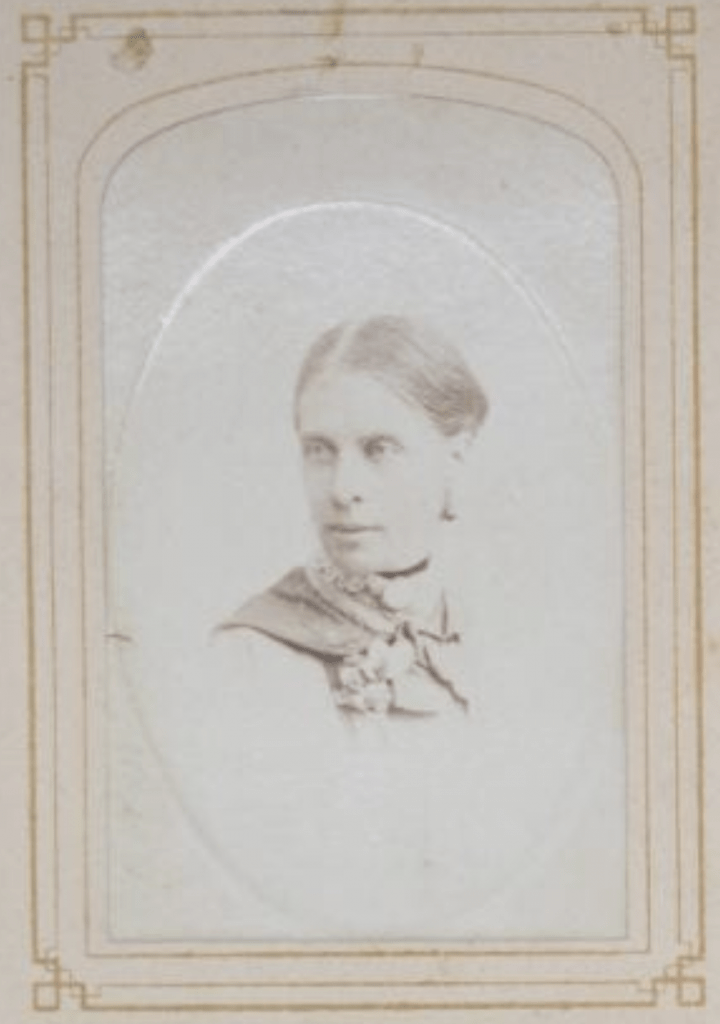
Emily Cumming Harris
28 March 1837-5 August 1925
In March 1837 my little daughter Emily Cumming was born. She was a very pretty child with large blue eyes, could read easy words at two years old. She was born in England, Plymouth, Devon. (Sarah Harris, A brief account of my life for my dear children)
I am a New Zealand artist & for a great many years have restricted my work to N.Z. subjects, flowers, birds, ferns, berries, grasses etc. […] I have been hoping to show you & Dr G.O. Bower the very large collection of original paintings I have in my Studio in oil & water colour large & small paintings finished pictures & panels – also portfolios of rough sketches the work of a long life devoted to making better known the lovely things more difficult to obtain each year. I am not a botanist but botanists have frequently sent me rare plants if they thought I had not got them. Many of my paintings have found their way to England & elsewhere. As a child I lived in the bush for some years & so became familiar with the forest trees & flowers & their manner of growth, & have also camped out many times.’
Also we had to try (encouraged by our dear mother) to educate ourselves. (Emily Harris to Alfred Barton Rendle, British Museum, 29 Aug 1914)
The Cyclopedia of New Zealand Vol 5. Nelson, Marlborough and Westland Provincial Districts. Christchurch: The Cyclopedia Company, 1906.
Commercial, Industrial And Professional (Nelson)
Harris, Miss Emily Cumming, Artist, Nile Street, Nelson. Miss Harris was born at Plymouth, England, and is a daughter of the late Mr. Edwin Harris, one of the first surveyors of Taranaki. She was educated in New Plymouth, but at the time of the Taranaki war was sent to Hobart, and re-joined her parents some years later in Nelson, where she has resided ever since. Miss Harris studied drawing in Hobart, and learned painting from her father, to whose careful instruction she owes her skill, and from whom she inherits her talent. In 1873, Miss Harris forwarded a number of paintings of New Zealand flora to an exhibition held in Nelson and Hokitika, and she gained a silver medal on each occasion. She forwarded a number of paintings to the Intercolonial Exhibition at Sydney in 1879, and received a first award and a medal, and also a first award at Melbourne in the following year. At the Anglo-Colonial Exhibition in London, Miss Harris obtained a general award with other exhibitors, and she has received many awards at Christchurch, Auckland and Wellington for works in oil and water-colour. Miss Harris, in conjunction with the late Mr. Jackson, of Nelson, published a very useful and interesting book, entitled “New Zealand Flowers, Berries and Ferns”; and she has also designed New Zealand floral autograph At-Home books. (NZETC)
Perhaps because of her professional activities as a painter and exhibitor of watercolours and oils from the 1870s until her death in 1925, Emily Cumming Harris has more photographs in public collections than her sisters. As a result we have been able to source images of Emily from several museums as well as the Harris Weyergang Album Photographique that show her as a young woman in Hobart through to middle and old age in Nelson.
Photo 1: Hobart
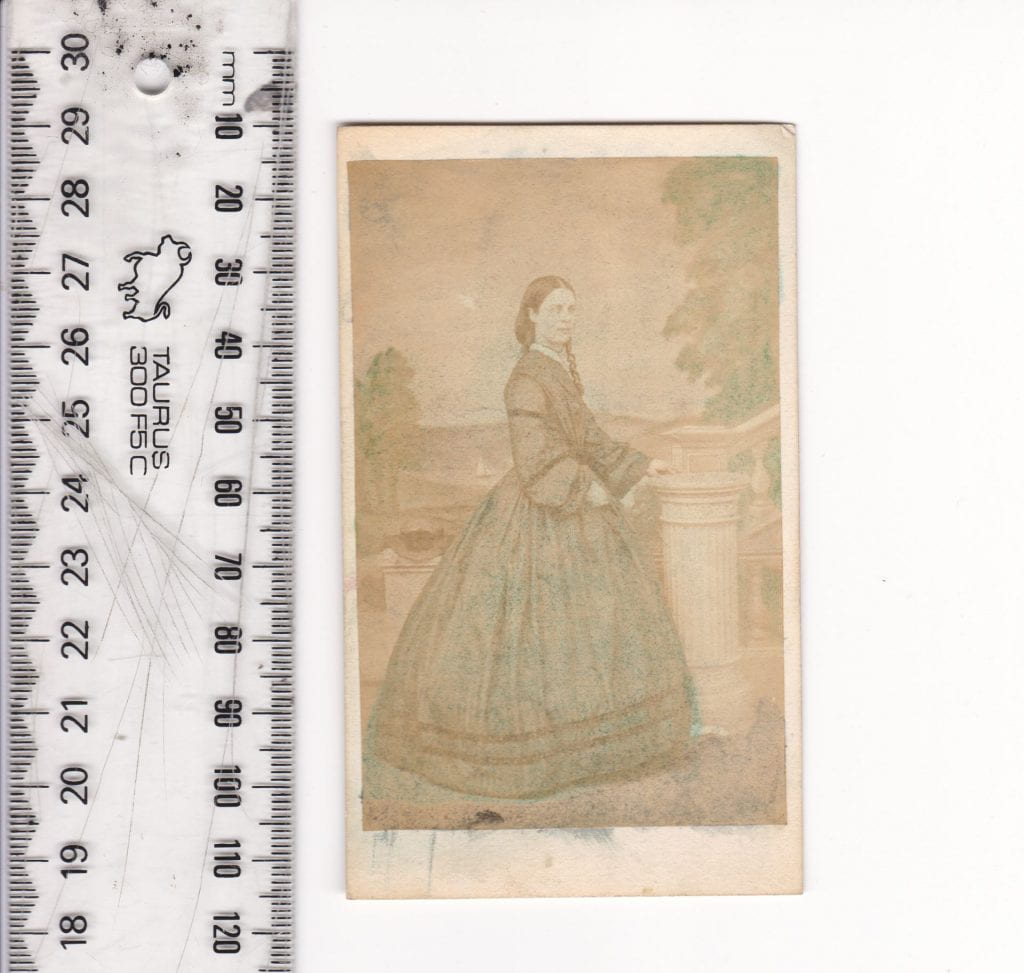

A full length portrait of Emily Harris in her 20s, her dress with full skirts and full sleeves, standing with a single hand resting on the pedestal beside her. Her hairstyle is in a more relaxed style than later photos, drawn back more softly and with a loose long curl to the side. Some detail is lost to us here but other photos by the photographer at the time show more details of the painted backdrop of hills and trees. Verso: WD Altiori City Photographic Establishment Alfred Bock 140 Elizabeth St Hobart Town. The second version has been photoshopped by Makyla Curtis to sharpen the faded print, in particular details of Emily’s face.
Photographer and Studio
Alfred Bock (1835-1920) was ‘one of the pioneers of early photography in the 19th century, along with his stepfather Thomas Bock, Alfred Bock also pursued a number of other interests including botany, painting and engraving. Mostly a resident of Tasmania, Bock also spent time in Victoria and New Zealand’ (Trove). This photo of Emily would have been taken during the period he operated the City Photographic Establishment 1858-1867 on Elizabeth Street in Hobart. Over time, Alfred Bock held premises in several different locations including 46 Campbell Street, 78 Liverpool Street, 138 Elizabeth Street and several others (Studios to 1900s).
Commentary
A hand-coloured portrait from the studio of artist and photographer Alfred Bock of 140 Elizabeth St, Hobart, preserved in the Harris Weyergang Album Photographique. The photograph is undated but must have been taken between 1861 and early 1865, when Emily left Hobart for Auckland. It has been hand-coloured with watercolour paint that has damaged the print. Either the photo chemicals or the type of card has prevented the watercolour from bonding with the paper and it has stayed on the surface of the card. Over time the colour has smudged and shifted on the photograph and has given the whole photo a green tinge.
Further reading about this photo: ‘Waiting for the Circus: Emily Harris in Hobart’
Photo 2
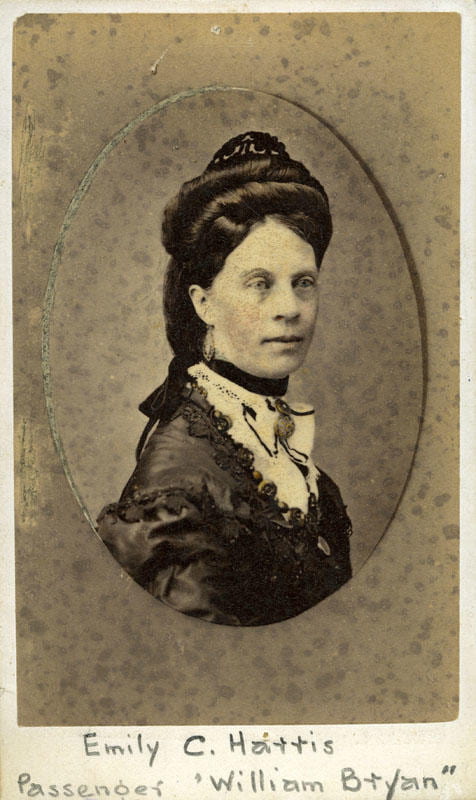
An oval photo set in rectangular card. Under the image is written: ‘Emily C. Harris, Passenger, William Bryan’. Emily’s hair is half-piled on top of her head and topped with a black filigree hair comb. There’s white lace around her neck from a white layer under the dress, flowery edging on the seams of dark dress at the neckline and on the shoulder where it meets the sleeve, teardrop shape earrings. There seems to be some slight added colour, a gold and bronze tinge visible on some of the necklace details, on the larger round flower-like beads and the round pendent at her throat. As well as a faint pink blush to the cheeks.
Commentary
Puke Ariki holds two print copies of this undated bust portrait of Emily Harris, no photographer or studio. The Taranaki Museum acquired the photograph along with a carte de visite of Emily’s mother Sarah Harris in the early 1940s as the museum assembled records of passengers who arrived in the region on the first immigrant ships. Likely donors of the Harris photographs are Emily’s nieces Constance and Ruth Moore of 23 Fulford St, New Plymouth. The Moore sisters also loaned Edwin Harris’s Spanish guitar to the museum at the time of centennial celebrations in 1941. In 1961 Ruth Moore and her younger sister Ella Grace Hobbs donated paintings and family papers to the Taranaki Museum that became the basis of the current Harris collection.
Photo 3: Melbourne
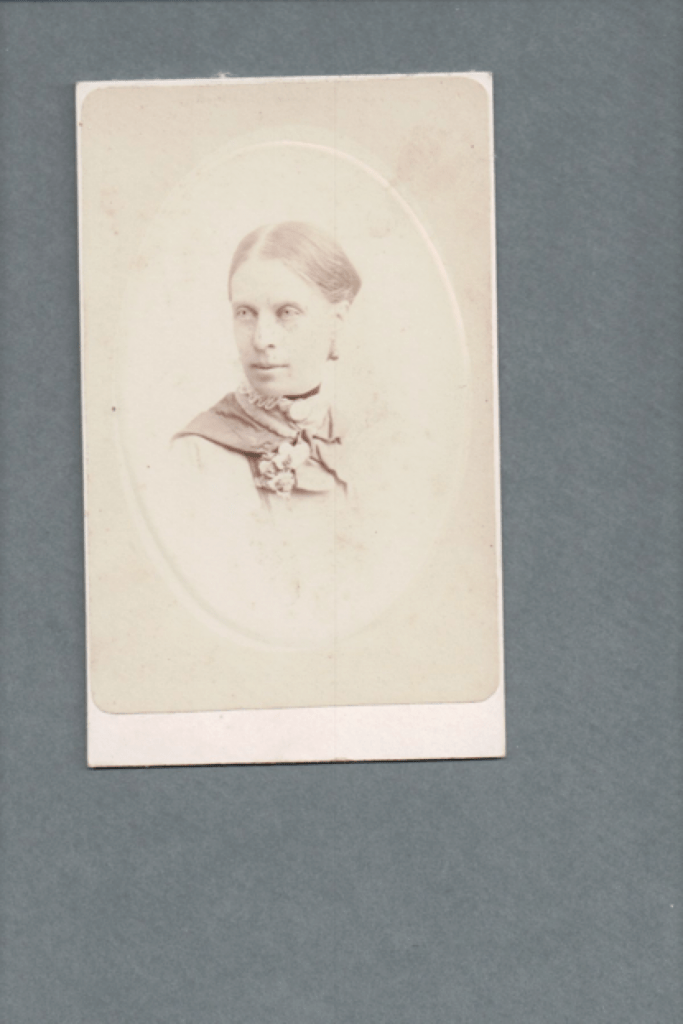

A head and shoulders photo of Emily Harris, aged 44, looking to the side, the background blank and the details soft. Her hair is pulled back behind her head. Present in both the Family Album and the Dunedin Public Library archives. Dunedin Public Library version (top) with the added inscription: ‘Emily Harris 1881.’ and Family Album version with the verso: ‘Stewart & Co. Photographers, Bourke Street, Melbourne.’
Photographer/Studio
Robert Stewart (1838- 1912) was a ‘professional photographer based in Sydney and Melbourne. Born in Scotland, he was working in partnership with Charles Pickering in Sydney from 1859 to 1861 and established his own studio in 1862. He transferred his business to Melbourne in 1871, and continued to work there until 1880. Robert’s brother Richard established the successful firm of Stewart & Co in Melbourne in 1871, which had 50 employees, four studios and six operators by 1887 and continued until 1915’ (Art Gallery).
There are some discrepancies around the historical account of Stewart & Co, Robert also reportedly being the one to establish the business not Richard. In fact, it looks like this Richard may not have existed at all, Robert not having a brother named Richard, and that it was actually Robert behind the Stewart & Co photographic studio. Read more at DAAO.
Commentary
One of two prints of a carte de visite portrait taken during Emily’s visit to Melbourne in 1880 during the Melbourne International Exhibition of 1880-81, in which she exhibited 28 watercolours of New Zealand wild flowers and berries earlier shown at the 1879-80 Sydney International Exhibition. Marshall Seifert of Dunedin donated the inscribed print to Dunedin Public Libraries in 2010.
Further reading about this photo: ‘Houhere (Lacebark) in Flower at Milford Sound’
Photo 4: Wellington
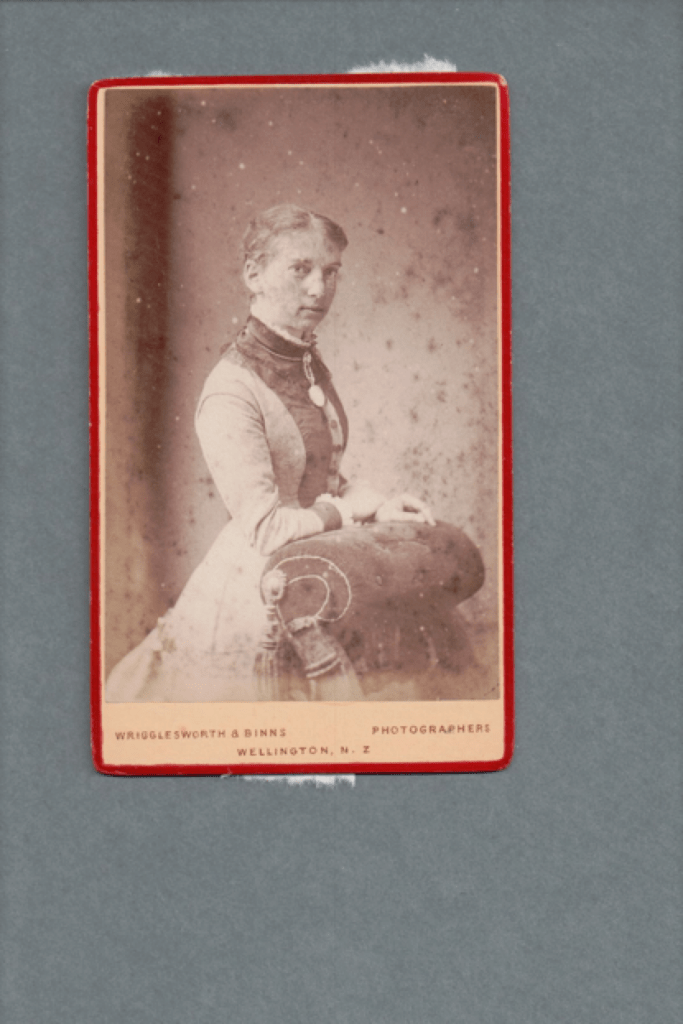
A half-length portrait photo of Emily Harris, aged 44, her arms resting on the plush headrest of a chaise that she’s standing behind, looking almost in the direction of the camera. She is wearing a buttoned-down dress or long coat that is a dark colour down the front and pale at the sleeves and sides. On the verso is ‘For Mrs Callis, with kind love, 8/3/81.’
Photographer/Studio:
D. Wigglesworth & F. C. Binns ran the very successful Wigglesworth & Binns photography studios, with branches in Wellington, Dunedin, and Christchurch. The firm was first established in 1863 by Wigglesworth who was then joined by Binns in 1871. Together, they achieved several awards for their photography work including first award at the Sydney exhibition in 1879, the same in Melbourne in 1881, and at the New Zealand exhibition of 1885 they carried off the only first award given in New Zealand for portrait photography. In 1901, their famous Willis Street premises in Wellington burnt to the ground, causing the destruction of thousands of negatives. It was promptly rebuilt with ‘no expense spared’, the three stories including the studio, reception rooms, work rooms, an office, a store-room, and a ‘dressing-room which ladies will declare to be a dream.’ (Early NZ Photographers).
Commentary
‘For Mrs Callis, with kind love, 8/3/81’ is made out to Mrs Mary Jane Callis, the wife of Charles Callis, whom Emily was acquainted with as the NZ commissioner for the Melbourne International Exhibition 1880-81. (Cyclopedia of NZ).’ Mary Jane Thomas (1846-1931) married Charles Callis in Islington, England in 1865. In 1871, they moved to Australia with their three-year-old son Charles and later moved to New Zealand in 1879. In 1885, Mary Callis became a driving force in the home industry exhibit in the 1885 New Zealand Industrial Exhibition in Wellington, where she went to the aid of the home industry exhibit, taking on the desperately needed arranging with some recruited friends.
Photo 5: Nelson
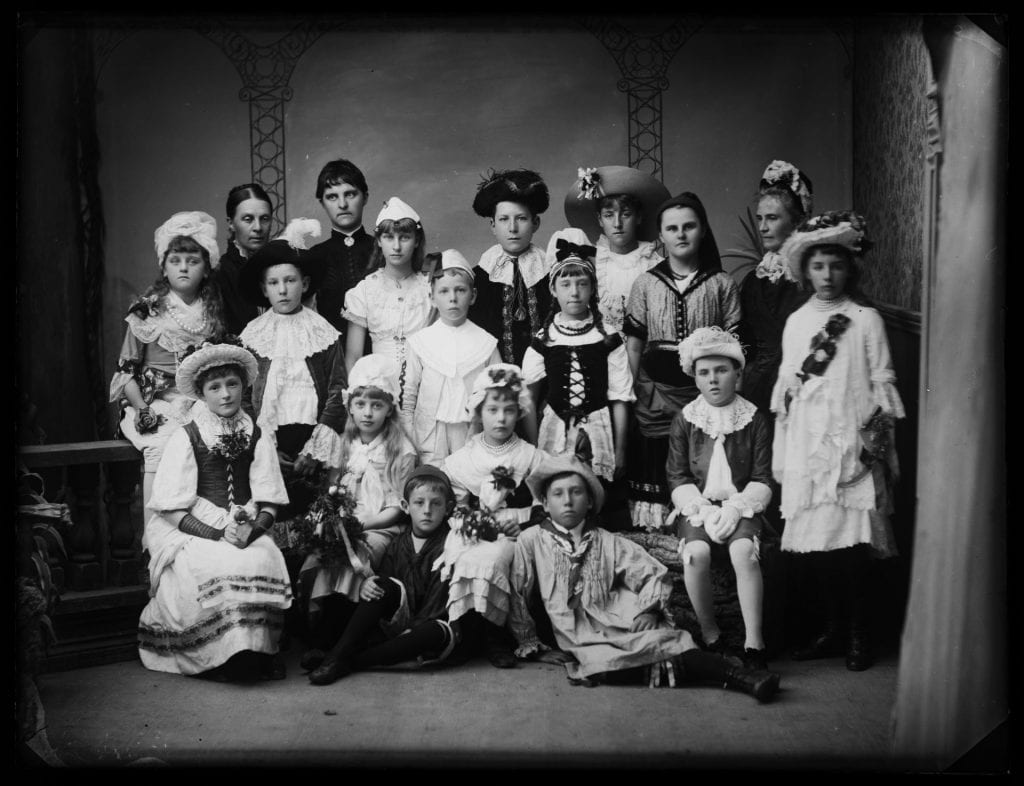
(Glass Plate Negative)
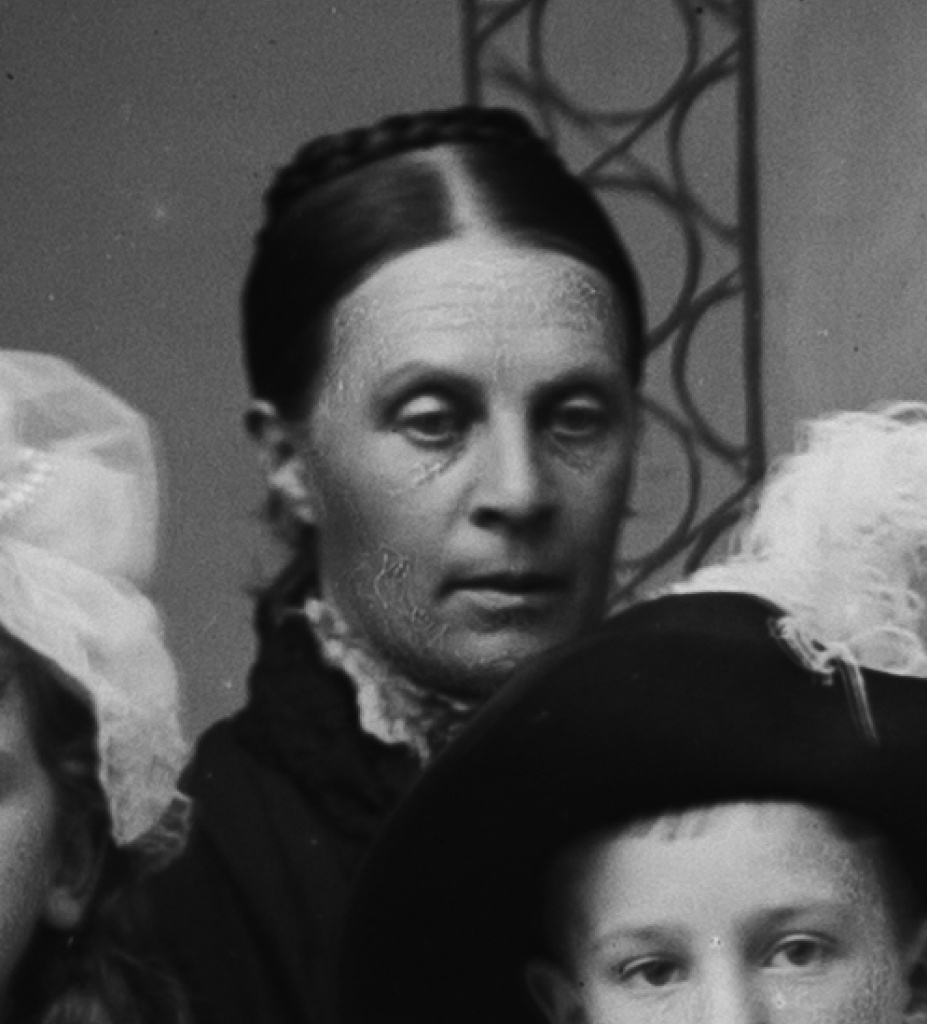
Emily Harris at the back of a group photo of dressed up children for The Olde Englyshe Fayre. She is at the very back on the left and not looking directly at the camera. In this close up, which is of the glass plate negative, there is a kind of distortion creating a ‘scaley’ effect on Emily and the others that isn’t representative of their real-life appearances. In the photo version of this glass plate negative at NPM, the results are more natural:
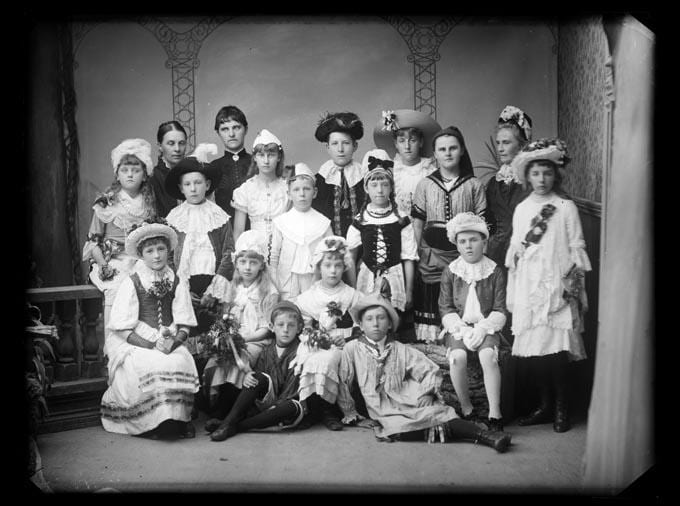
Photographer/Studio
This photo is from the Tyree Studio:
‘This amazing collection officially starts from 1878, but there are some negatives inherited from an earlier photographer and plates actually go back to the mid 1860’s. The business was started by William Tyree who came to Nelson in 1878 at the age of 24. The family was one with wide photographic interests. His brother, Frederick, came out from London and after a sojourn in Dunedin later joined William and concentrated on the landscape aspect. Another brother, Alfred, was a photographer in Christchurch’ (Canterbury Photography).
Commentary
The Tyree collection does not identify or date the photograph of Nelson children costumed as maypole dancers, but we can make an educated guess at both by referring to Emily Harris’s diary which details extensive preparations for the city’s first-ever Maypole dance at the Olde Englische Fayre in December 1885. The children were pupils at the Harris sisters’ school. They were trained by Frances, Emily and Ellen Harris and the performance was described in local newspapers. We think the adult figure at back left is Emily Harris.
Further reading about this photo: Ned’s dress
Nelson Provincial Museum Photos 6-9
Four photos of Emily Cumming Harris in her 60s in 1898-99. Her hair is now white and is done up with black ribbon (and in one case, a headpiece with beading and ribbon). She wears a brooch at her throat above a necklace with a small oval pendant.
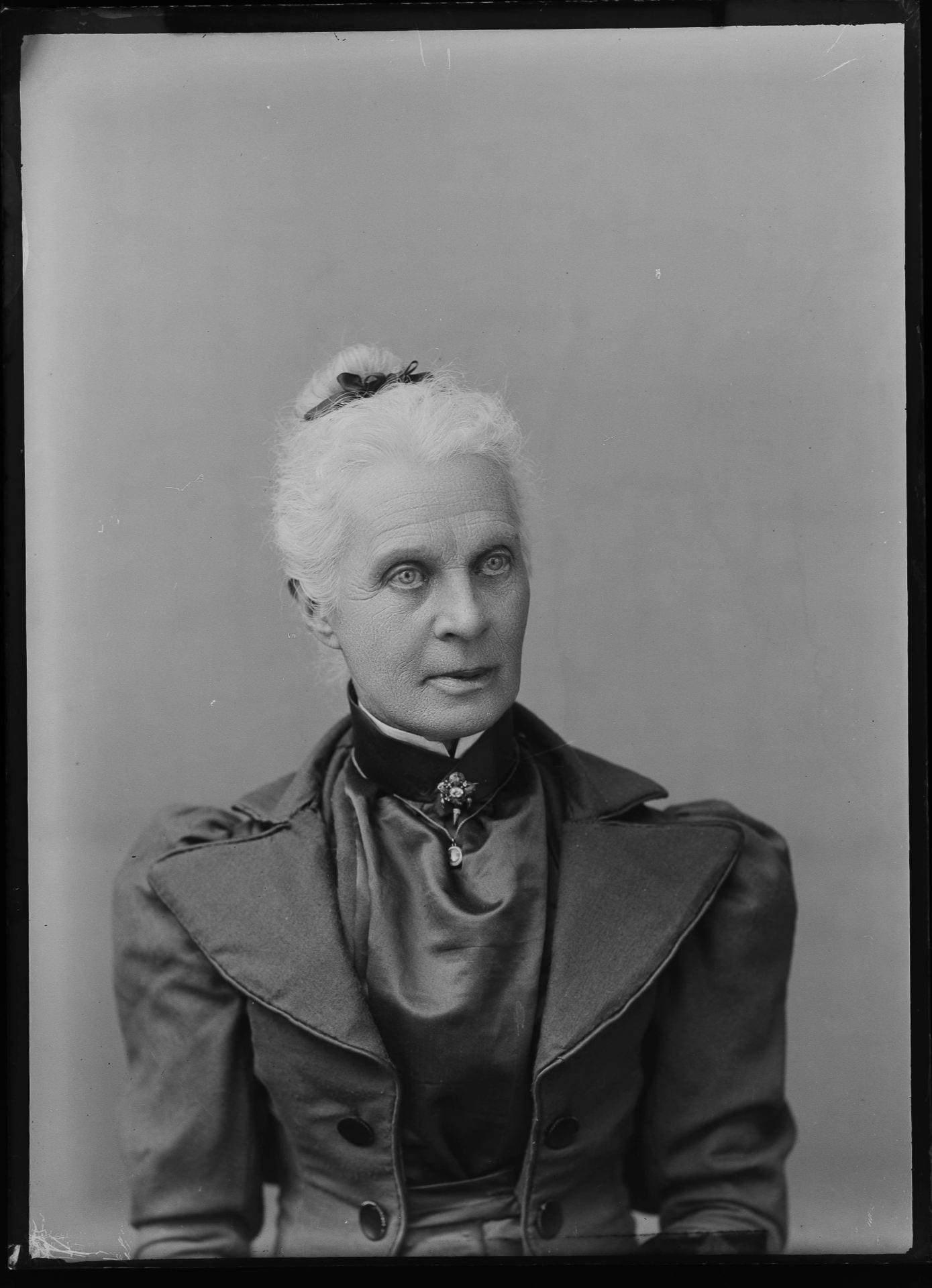
55511. The first photo of this group has been retouched, Emily’s skin is notably more wrinkle-free than in the next three photos.

55512. The second photo features Emily with a headpiece with significant beading, ribbon, and whiffs of lace all in dark colours.

55513. The third photo has Emily caught in the moment of a blink, looking at the eyes you can both see the eye and the translucent closed eyelid.

55514. In the fourth photo, Emily has switched into a different outfit- a dark dress patterned with a delicate line-dot-line design.
Studio/Photographer
While not assigned a photographer, these photos in the Nelson Provincial Museum’s Tyree Collection are likely to have been taken (and retouched!) by Rose Frank, Tyree’s assistant and later business partner.
From The Prow:
‘Rosaline Margaret Frank (or Rose Frank) was one of New Zealand’s first professional women photographers, and the first in Nelson. She was born on 21 December 1864. the daughter of Christopher and Emma Frank and was a foundation pupil of the Nelson Roman Catholic Convent.
At the age of 21 she went to work at the Tyree Photographic Studio in Trafalgar Street, Nelson, which was opened in 1878 by William Tyree. His brother Frederick worked with him for some years. In 1895 she became manager of the studio with power of attorney for the business. William Tyree moved to Sydney, Australia, later that year and Rose continued running the studio in Nelson, also acting as agent for William Tyree’s acetylene gas generators. In 1914 Rose Frank purchased the studio and continued to operate it under the original name until her retirement in 1947 aged eighty two. Rose Frank is considered to be the first woman in New Zealand to have been professionally involved in photography. She was also actively involved in art and music.
In 1948 the Alexander Turnbull Library, Wellington, purchased some 1,100 negatives she had stored in a strongroom. Just before her death Rose Frank gifted the Nelson Historical Society the remaining negatives (between 110,000 and 120,000) which are held at the Nelson Provincial Museum. She died in 1954 aged eighty nine. Rosaline’s main interests were photography, art and music. It was Rosaline who preserved the Tyree glass plate negatives’.
Further reading on Rose Frank is available at Te Ara
Commentary
Around this time in 1899, Emily held exhibitions in Nelson and New Plymouth to raise subscriptions for publishing her book New Zealand Mountain Flora in colour. The first paintings for the project were produced in 1890 during a camping trip to the lower slopes of Mount Taranaki that brought Emily into contact with alpine meadows in full flower.
Further Reading on Emily Cumming Harris
As could be expected of a project named Emily Cumming Harris in New Zealand and Australia, there is much further reading on Emily Harris on this website. Emily’s timeline features in the Harris Family in NZ timeline in more detail and Writing Lines: Emily Harris Letters and Diary Excerpts 1860–1863 is online for perusal, with some highlights featured here. Our next big project also concerns Emily, her diaries themselves in the process of being reviewed and edited for Drawing Lines, with a preview available currently online.
Emily also features in many of this website’s blog posts, going into more detail about other aspects of Emily’s life from the life of her studio, to the school she ran with her sister, her love of camping and an 1888 camping trip, and posts on the research process: ‘Flames and Archives’, ‘Emily at the Natural History Museum, London’, ‘The Emily line in NSW: Moore, Tregeagle, Needham’, and ‘Emily and the Suter Gift Book‘.
Sisters at a Glance: Navigation
#0 Introduction
#1 Emily Cumming Harris: Here
#2 Catherine Harris
#3 Unnamed Daughter
#4 Frances Emma Harris
#5 Mary Rendel Harris
#6 Augusta Harris
#7 Ellen Harris
Lead writers: Michele Leggott and Brianna Vincent
Research Support: Dasha Zapisetskaya, Makyla Curtis, Betty Davis
I love the Tyree photos. The first three were clearly a portrait session. I see a very slight amused smile on her face when she is wearing the elaborate head dress.
Is there enough difference in the two dresses to give a clue about yearly fashion changes?